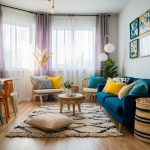Transform Your Home’s Aesthetic with Budget Chic Décor Tips
Creating a stylish home doesn’t have to break the bank. With a few strategic changes, anyone can breathe new life into their living space without overspending. Refreshing the aesthetic can be as simple as adding a new accent wall or incorporating a few key decor pieces that align with personal style.
Functional elements should not be overlooked, as they play a crucial role in both appearance and utility. Incorporating decor that serves a purpose ensures that the home looks beautiful while catering to everyday needs. Whether it’s through maximizing space or choosing the right lighting, functionality enhances both style and comfort.
Choosing decor that reflects individual tastes is vital in making a home truly feel like one’s own. Personal style should guide decisions from color schemes to furniture choices, ensuring every space is as unique as its owner. This mix of aesthetic appeal and practicality is the key to achieving budget-friendly, chic home decor.
Defining Your Style on a Budget
Creating a chic home doesn’t have to drain your wallet. By grasping essential design principles and mixing in unique thrift finds, anyone can design a personalized space that is both stylish and budget-friendly.
Understanding Core Design Principles
Comprehending the fundamental elements of design is crucial when decorating on a budget. It starts with the balance of a room, ensuring that visual weight is evenly distributed, whether through symmetry or asymmetry. Harmony and contrast are essential to make sure that the decor fits together cohesively while still inviting attention to focal points. Skilled use of color can significantly affect the atmosphere and perception of space, often making it look more spacious or intimate depending on the chosen palette.
Proportion and scale are also significant, influencing how furniture and accessories relate to one another and the room’s dimensions. Opting for a neutral color base allows flexibility for adding different accent pieces from thrift stores or budget shops. It’s about creating a cohesive look without spending excessively.
Incorporating Personal Flair with Thrift Finds
Thrift stores are treasure troves for unique decorations that can add individuality to any home. They offer an array of options like vintage furniture, artwork, and unusual collectibles that can harmonize with existing decor. Picking up a vintage chair or mid-century lamp can infuse character and nostalgia into a room without costing much.
Creativity is key when working with thrift items. Refinishing or repainting pieces can elevate their appeal and integrate them seamlessly into any design scheme. Mixing old-world charm with modern aesthetics allows one to express their personal style without straining their finances. Regular visits to local thrift shops can yield new gems that keep decor fresh and personalized.
Maximizing Functionality and Aesthetics
Achieving both functionality and aesthetics in your home involves strategic furniture placement and the use of pieces that serve multiple purposes. Thoughtfully designed spaces can transform how you experience your home.
Furniture Arrangement Techniques
Strategically arranging furniture can dramatically influence both the functionality and beauty of a room. Key to this is understanding your space. Begin with considering traffic flow; ensure paths are clear and logical. This prevents clutter and maintains an open feel. Start with focal pieces like a sofa or a main table, and arrange secondary pieces around them with purpose.
Creating balance is crucial. For instance, if one side of the room has large furniture, balance it with artwork or a plant on the opposite side. Use area rugs to define spaces, especially in open-concept homes. They help to anchor furniture, creating distinct zones for different activities.
Furniture should also be set at varying heights to add dimension. Think of your room in layers: ground level (rugs), seating level (sofas and chairs), and eye level (art and shelves). This layering approach adds interest while maintaining harmony.



